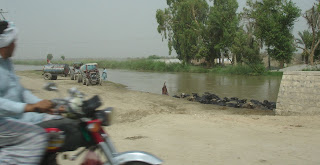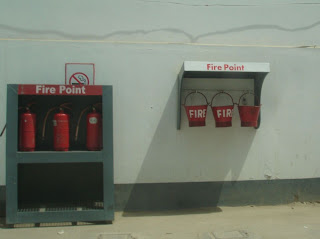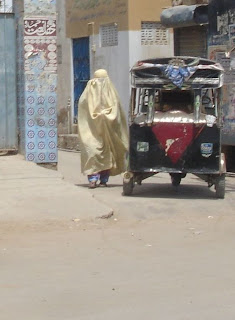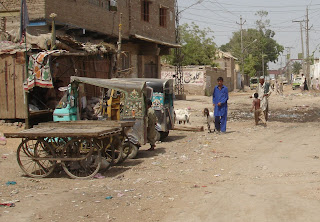One of things that I was asked to do was to attend a formal ceremony at which we were fed a boxed lunch. The box is actually a recycled cereal box, and when you open it you see what was formerly on the outside. This is the second time that it's happened, so I suspect that it's common practice.
 There is an old fort on the Indus River in Sukkur, it's on an island and so the river looks only half as wide as it normally is. Because it was incredibly hot (over 45°C/113°F), boys were swimming in the river.
There is an old fort on the Indus River in Sukkur, it's on an island and so the river looks only half as wide as it normally is. Because it was incredibly hot (over 45°C/113°F), boys were swimming in the river. as were buffaloes
as were buffaloes On of the problems facing Sukkur is the lack of appropriate solid waste collection. Thankfully, goats and sometimes cows consume a fair amount of the organic material.
On of the problems facing Sukkur is the lack of appropriate solid waste collection. Thankfully, goats and sometimes cows consume a fair amount of the organic material. The other animal that you see a lot around is the donkey. There are many donkey carts that people will carry all manners of stuff on.
The other animal that you see a lot around is the donkey. There are many donkey carts that people will carry all manners of stuff on. Water supply in Sukkur is not sufficient, so people have installed hand-pumps from which they draw underground water. On the picture below, you also see another classic: the open manhole (very dangerous).
Water supply in Sukkur is not sufficient, so people have installed hand-pumps from which they draw underground water. On the picture below, you also see another classic: the open manhole (very dangerous).
This fire fighting equipment was seen at a petrol station.
 Whereas most women in Karachi and Lahore will wear a hijab or no veil at all (one can also see a few niqabs), there is a significant number of women in Sukkur and the surrounding area who will wear yellow burqas such as the one below. I didn't see any black or blue ones. I wonder if there is a significance to the color or not. There are also very few women in the streets, as compared to Karachi or Lahore.
Whereas most women in Karachi and Lahore will wear a hijab or no veil at all (one can also see a few niqabs), there is a significant number of women in Sukkur and the surrounding area who will wear yellow burqas such as the one below. I didn't see any black or blue ones. I wonder if there is a significance to the color or not. There are also very few women in the streets, as compared to Karachi or Lahore. In addition to the old fort, Sukkur has a few nice buildings, including this mosque.
In addition to the old fort, Sukkur has a few nice buildings, including this mosque. As everywhere else in the developing world, those who can afford it have a bicycle, and will ride it even in the punishing heat.
As everywhere else in the developing world, those who can afford it have a bicycle, and will ride it even in the punishing heat. Another option for transport is these overcrowded minibuses. Without air conditioning and room to move, I think I might prefer a bicycle.
Another option for transport is these overcrowded minibuses. Without air conditioning and room to move, I think I might prefer a bicycle. Around Sukkur, some traditional houses are made with reeds from the banks of the Indus and the many canals that criss-cross the region.
Around Sukkur, some traditional houses are made with reeds from the banks of the Indus and the many canals that criss-cross the region. There are also dozens of brick factories such as this one. Notice the date palms in the back, which the region is famous for. Don't be fooled by the electrical wires, power is available only a few hours a day, as load shedding is prevalent (the cause of the lack of electricity appears to be in part a dispute with India over water, on which I have no opinion).
There are also dozens of brick factories such as this one. Notice the date palms in the back, which the region is famous for. Don't be fooled by the electrical wires, power is available only a few hours a day, as load shedding is prevalent (the cause of the lack of electricity appears to be in part a dispute with India over water, on which I have no opinion). In the poorest part of Sukkur, the roads aren't paved, which leads to puddles of sewage in the streets. You can also see a small flock of goats, a donkey cart, and two tuk-tuks.
In the poorest part of Sukkur, the roads aren't paved, which leads to puddles of sewage in the streets. You can also see a small flock of goats, a donkey cart, and two tuk-tuks.